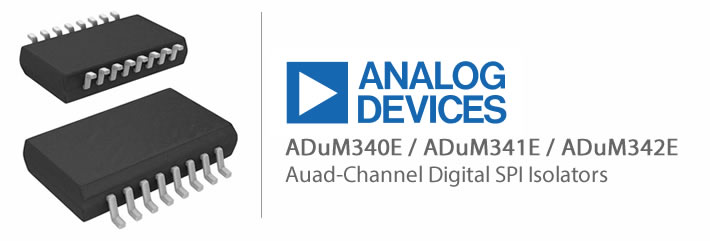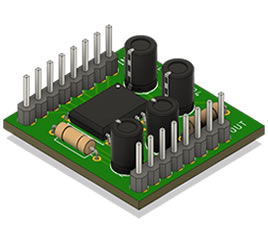The Analog Devices ADuM340E / ADuM341E / ADuM342E is an isolated high-speed, voltage-mode, single-channel digital isolator based on Analog Devices, Inc., iCoupler® technology. It uses an integrated transformer to provide galvanic isolation of up to 2500V RMS for 2 seconds. The device provides electrical isolation between two sides of a circuit while allowing signals to be transmitted between them, providing protection against voltage transients and ground loops. It operates using an SPI interface and is commonly used in industrial, medical, and automotive applications where the isolation of signals is required.

How ADuM340E / ADuM341E / ADuM342E works?
The ADUM3401 works by using transformer-based isolation technology to electrically isolate the input and output signals. The device has two independent signal paths, one for the input and one for the output, that is electrically isolated from each other. The input signals are transmitted across the isolation barrier using a transformer, while the output signals are generated by a digital isolator. This isolation mechanism helps to prevent ground loops, reduce noise, and protect sensitive electronic equipment from high voltage spikes.
In terms of the SPI interface, the ADUM3401 receives the SPI data signals from the input side, isolates and translates the level of the signals, and then re-transmits the signals on the output side. This allows for communication between two separate systems while maintaining electrical isolation between them. The ADUM3401 also provides data rate flexibility, allowing for data transfer rates of up to 10 Mbps.
This ADUM3401 is well suited for a range of industrial, automotive, and medical applications where electrical isolation is required. Some of the common applications for the ADUM3401 include:
- Industrial control systems: The ADUM3401 can be used to isolate control signals between the control system and field devices in industrial applications, such as programmable logic controllers (PLCs), human-machine interfaces (HMIs), and sensors.
- Automotive systems: The ADUM3401 can be used to isolate communication signals between different electronic control units (ECUs) in an automotive system, helping to protect against electrical noise and high voltage spikes.
- Medical equipment: The ADUM3401 can be used to isolate communication signals in medical equipment, such as patient monitors, infusion pumps, and imaging systems, helping to ensure patient safety.
- Power electronics: The ADUM3401 can be used to isolate communication signals between the control system and power electronics, such as inverters, rectifiers, and battery management systems, helping to prevent ground loops and reduce noise.
- Other applications: The ADUM3401 can be used in a variety of other applications where electrical isolation is required, such as renewable energy systems, building automation, and test and measurement equipment.
The ADUM3401 is typically controlled by a microcontroller through the SPI interface. The microcontroller communicates with the ADUM3401 by sending and receiving data via the SPI bus.
To operate the ADUM3401, the microcontroller must first initialize the SPI interface and configure the ADUM3401 for the desired operating parameters, such as the data transfer rate and communication direction. The microcontroller then sends and receives data to and from the ADUM3401 over the SPI bus.
When sending data, the microcontroller sends a series of clock pulses and data bits to the ADUM3401, which in turn isolates and translates the data signals and transmits them to the output side. When receiving data, the microcontroller receives data bits from the ADUM3401 over the SPI bus and processes the data as necessary.
In summary, the ADUM3401 operates as an SPI interface device that isolates and translates data signals between a microcontroller and other system components. The Microcontroller communicates with the ADUM3401 through the SPI bus and controls the device’s operations through the configuration and data transfer process.
The voltage input of the ADUM3401 SPI isolator is 3.3V or 5V, depending on the version of the device. The ADUM3401 is available in two versions: one with a 3.3V supply voltage and another with a 5V supply voltage. The supply voltage range for both versions is 2.7V to 5.5V.
It is important to choose the correct version of the ADUM3401 based on the voltage requirements of the system in which it will be used. Using the correct supply voltage will help to ensure the proper operation of the ADUM3401 and minimize the risk of damage to the device or other system components.
As you can see the diagram below it uses a BME280 digital humidity, pressure, and temperature sensor that is manufactured by Bosch Sensortec. It is a small, low-power, and highly accurate sensor that is commonly used in a range of applications, including weather stations, home automation systems, and mobile devices.
For this example, as you can see in the diagram below, we used BME280 SPI for interfacing the ADUM3401 the BME280 integrates a humidity sensor, a pressure sensor, and a temperature sensor into a single package, allowing for the simultaneous measurement of all three parameters. The sensor uses temperature compensation algorithms to accurately compensate for temperature-induced variations in the humidity and pressure readings, providing highly accurate and stable measurements. The BME280 communicates with a MCU/Microcontroller or other system components using an I2C or SPI interface. The sensor can be configured through software to adjust various parameters, such as the measurement rate, filter parameters, and operating modes. The BME280 provides a simple and cost-effective solution for applications that require simultaneous measurement of humidity, pressure, and temperature.
This BME280 is a versatile and widely used sensor that is well-suited for a variety of applications due to its small size, low power consumption, and high accuracy. Some of the common applications for the BME280 include:
- Weather stations: The BME280 can be used to measure temperature, pressure, and humidity in weather stations, allowing for the accurate measurement of atmospheric conditions.
- Home automation: The BME280 can be used to measure indoor temperature, pressure, and humidity in home automation systems, providing information that can be used to control heating and cooling systems, adjust lighting, and more.
- Mobile devices: The BME280 can be integrated into mobile devices, such as smartphones and tablets, to provide environmental sensing capabilities.
- Agriculture: The BME280 can be used to measure soil moisture, temperature, and atmospheric pressure in agricultural applications, helping to optimize crop growth and improve crop yields.
- HVAC systems: The BME280 can be used to measure indoor temperature, pressure, and humidity in heating, ventilation, and air conditioning (HVAC) systems, helping to improve indoor air quality and energy efficiency.
- Other applications: The BME280 can also be used in a variety of other applications, such as wearable devices, sports and fitness equipment, and environmental monitoring systems.
For more technical details please refer to the datasheet below.
Requirements
- Arduino IDE | VisualStudio Code | PlatformIO
- Test Boards :
- Note: The Diagram below is using ATMEGA328X MCU (please refer to your MCU’s respective pin-outs & bus configuration)
- ADuM340E / ADuM341E / ADuM342E
- BME280
- Resistors (See below diagram for required value & alternatives package)
- Capacitor(See below diagram for required value & alternatives package)
Wiring Diagram / Schematics
Sketch Source Code
[crayon-67eedc7b7e9f1924144692/]
Python Code ( CircuitPython / MicroPython )
[crayon-67eedc7b7e9fc649937679/]
PCB Milling / Gerber
- Download PCB Milling File | 14CORE-ADUM34
- Download Gerber Viewer | Windows | Linux
Downloads
- Download Analog Devices ADuM340E / ADuM341E / ADuM342E Datasheet | PDF
- Download Analog Devices Functional SPI Isolation Documentation | PDF
- Download BOSCH BME280 Code Library | Zip
- Download BOSCH BME280 Datasheet | Zip
